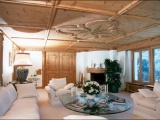Experimental procedure
A balanced, crossed repetitive measuring design was car- ried out under psychological and physical stress situations in the laboratory over 24 hours in everyday life situations of the test subjects. With the help of high resolution electrocardiogram recorders the heart frequency and its variability, vegetative parameters and the biological rhythms characteristic of recovery were investigated. Psychometric methods were implemented for the measurement of well-being, vigilance and subjective sleep quality.
Stress and recovery ability in Stone Pine room
For the battery of tests carried out in the lab significant differences were found between the quality of recovery of subjects spending time in Stone Pine rooms and those in identically arranged “wood imitation” rooms. This ex- pressed itself in a lower heart rate during physical and mental stress situations and following rest phases and/or during an accelerated autonomic recovery process. The heart frequency of the test subjects in the wood imitation room is dependent on the atmospheric pressure. This meteorosensitivity is a sign of an unstable circulation. In the Stone Pine room the heart rate seems to be inde- pendent of the atmospheric pressure.
AutoChrone image of the entire measurement in the Stone Pine room
Stone Pine – the natural way to a good night’s sleep!
Autonomic balance in different beds (blue reflects recovery periods)
Quality of sleep in the Stone Pine bed
In the second study a possible influence of the bed ma- terial on the quality of sleep was investigated. The vol- unteers spent their nights, this time for a longer period (~3 weeks), first in a Stone Pine (green), then in their own bed and /or in a wood imitation bed (red). The long-term investigation confirmed a significant influence of the construction material on the physical and psycho- logical condition. The sleep quality was clearly improved in the Stone Pine bed compared to that of the wood imitation bed.
The improved recuperation was accompanied by a reduced heart frequency and an increased oscillation of the organism in the course of the day. The average “saving” in the Stone Pine bed was about 3,500 heart- beats per day, which corresponds to about an hour’s “heart-work”. The subjective feeling of well-being of the test subjects matched these physiological results: The Stone Pine subjects reported feeling more relaxed, feel- ing generally fitter and, surprisingly, were socially more extraverted than beforehand. Could this be a reason why pubs and other social rooms (in this region) were panelled with Stone Pine in former times?
Material for furnishing would appear to have a more significant effect on well-being and health than hitherto imagined. This opens up new fields of application for the high-grade wood of the “Queen of the Alps”.
Saving of “heart-work” during the course of the day by sleep in the Stone Pine bed
JOANNEUM RESEARCH Forschungsgesellschaft GmbH
one of Austria’s largest institutions in the field of applied research and development, offers its expertise to business, industry and administration. With a staff of more than 370 highly skilled experts JOANNEUM RESEARCH is active at national and international levels in all important sectors of innovation.










